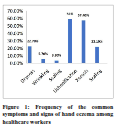Hand hygiene practice and hand eczema among healthcare workers during COVID-19 pandemic in a tertiary hospital in Southern Nigeria
Main Article Content
Abstract
Background: Hand eczema is common among those occupationally exposed to intense wet work and chemical irritants such as healthcare workers. The risk may be increased during this coronavirus disease (COVID)-19 period because regular hand hygiene is one of the recommended strategies for curbing the spread of coronavirus. However, overzealous hand washing among healthcare workers may lead to hand eczema and some attendant consequences such as reduced quality of life.
Aim: To determine the prevalence of hand eczema amongst healthcare workers and associated factors among healthcare workers in a tertiary hospital in Southern Nigerian.
Methods: This was a cross-sectional descriptive study that was done amongst healthcare workers in Nigerian tertiary hospital. Patients were examined for hand eczema after obtaining information on their hygiene practices and symptoms of hand eczema. P value of 0.05 was considered significant.
Results: Three hundred and seventeen healthcare workers comprising of 140(44.2%) females and 177(55.8%) males with a mean age of 34.13± 6.82 years participated in the study. There was significant increase in the frequency of hand washing in the COVID-19 era (p =<0.001). The prevalence of hand eczema amongst healthcare workers was 64.7%. The common skin lesions observed were lichenification [187(59%)], xerosis [182(57.4%)] and scales [70(22.1%)]. There was no significant association between hand eczema and age, profession and gender of the health worker (p = >0.05).
Conclusion: Hand eczema was highly prevalent among healthcare workers during this COVID-19 era. There is need to regularly educate the general public on proper and rational hand hygiene.
Downloads
Article Details

This work is licensed under a Creative Commons Attribution-NonCommercial-ShareAlike 4.0 International License.
The journal grants the right to make small numbers of printed copies for their personal non-commercial use under Creative Commons Attribution-Noncommercial-Share Alike 3.0 Unported License.
References
1. World Health Organization. WHO Situation Report on COVID-19. Available from: https://www.who.int/ emergencies/ diseases/novel-coronavirus-2019/situation-reports. Accessed on 12th December, 2020.
2. WHO Director General. WHO Director General’s opening remarks at media briefing on COVID-19 on March 11, 2020. Available from: https://www.who.int/dg/speeches/detail/who-director-general-s-opening-remarks-at-the-media-briefing-on-covid-19---11-
march-2020. Accessed on 12th December, 2020.
3. European Centre for Disease Prevention and Control. COVID-19 situation update report. Available from: https://www.ecdc.europa.eu/en/ geographical-distribution-2019-ncov-cases. Accessed on 12th December, 2020.
4. World Health Organization. Interim recommendations on obligatory hand hygiene against transmission of COVID-19. Available from: https://www.who.int/docs/default-source/inaugural-who-partners-forum/who-interim-recommendation-on-obligatory-hand-hygiene-against-transmission-of-covid-19.pdf. Accessed on 12th December, 2020.
5. Khosrowpour Z, Ahmad Nasrollahi S, Ayatollahi A, Samadi A, Firooz A. Effects of four soaps on skin trans-epidermal water loss and erythema index. J Cosmet Dermatol 2019;18(3):857–861.
6. Lan J, Song Z, Miao X, Li H, Li Y, Dong L, et al. Skin damage among health care workers managing coronavirus disease 2019. J Am Acad Dermatol 2020;82(5):1215-1216.
7. World Health Organization. WHO Guidelines on Hand Hygiene in Health Care: First Global Patient Safety Challenge - Clean Care Is Safer Care. Geneva: World Health Organization, 2009.
8. Hamming I, Timens W, Bulthuis ML, Lely AT, Navis GV, van Goor H. Tissue distribution of ACE2 protein, the functional receptor for SARS coronavirus. A first step in understanding SARS pathogenesis. J Pathol 2004;203(2):631-637.
9. Cavanagh G, Wambier CG. Rational hand hygiene during the coronavirus 2019 (COVID-19) pandemic. J Am Acad Dermatol 2020;82(6):e211.
10. Yan Y, Chen H, Chen L, Cheng B, Diao P, Dong L, et al. Consensus of Chinese experts on protection of skin and mucous membrane barrier for health‐care workers fighting against coronavirus disease 2019. Dermatol Ther 2020;33(4):e13310.
11. Gasparini G, Carmisciano L, Giberti I, Murgioni F, Parodi A, Gallo R. Healthy Hands: a pilot study for the prevention of chronic hand eczema in healthcare workers of an Italian University Hospital. G Ital Dermatol Venereol 2020;155(6):760-763.
12. Ibler KS, Jemec GB, Agner T. Exposures related to hand eczema: a study of
healthcare workers. Contact Dermatitis 2012;66(5):247-253.
13. Guertler A, Moellhoff N, Schenck TL, Hagen CS, Kendziora B, Giunta RE, et al. Onset of occupational hand eczema among healthcare workers during the SARS‐CoV‐2 pandemic: Comparing a single surgical site with a COVID‐19 intensive care unit. Contact Dermatitis 2020; 83(2):
108-114.
14. Johannisson A, Pontén A, Svensson Å. Prevalence, incidence and predictive factors for hand eczema in young adults – a follow-up study. BMC Dermatol 2013;13:14.
15. Beiu C, Mihai M, Popa L, Cima L, Popescu MN. Frequent hand washing for COVID-19 prevention can cause hand dermatitis: management tips. Cureus2020;12(4):e7506.
16. Warne RR. Buissy YL, Lilly NA, Spears MJ, McKillop K, Marshall JL, et al. Water disrupts stratum corneum lipid lamellae: Damage is similar to sulfactants. J Invest Dermatol 1999;113(6):960-966.
17. Singh M, Pawar M, Bothra A, Choudhary N. Overzealous hand hygiene during the COVID 19 pandemic causing an increased incidence of hand eczema among general population. J Am Acad Dermatol 2020;83(1):e37-e41.
18. Hamnerius N, Svedman C, Bergendorff O, Bjork J, Bruze M, Ponten A. Wet work exposure and hand eczema among healthcare workers: a cross-sectional study. Br J Dermatol 2018;178(2):452–461.
19. Lee SW, Cheong SH, Byun JY, Choi YW, Choi HY. Occupational hand eczema among nursing staffs in Korea: self-reported hand eczema and contact sensitization of hospital nursing staffs. J Dermatol 2013;40(3):182–187.
20. Resch LC, Sandven I, Brenno P, Bakkerud T, Danielsen TE, Alfonso JH. Prevalence and risk factors for hand eczema among Norwegian specialist nurses: a cross-sectional study.Occup Environ Med 2018;75(Suppl 2):A339.


